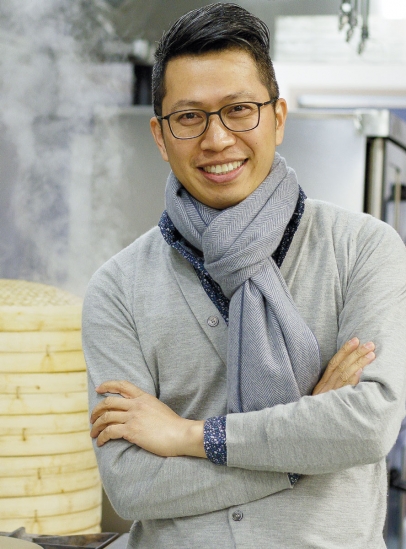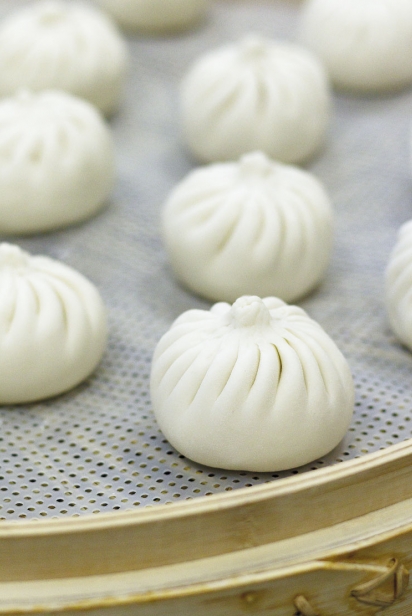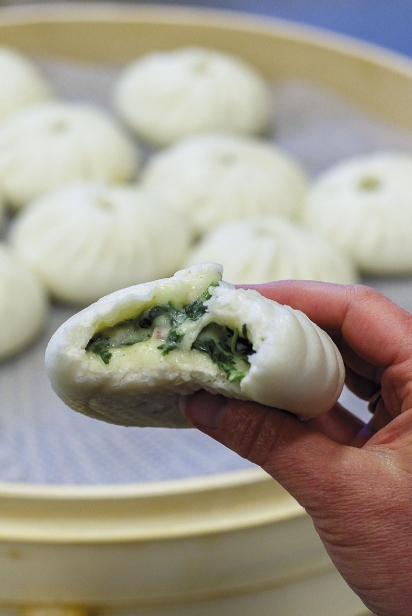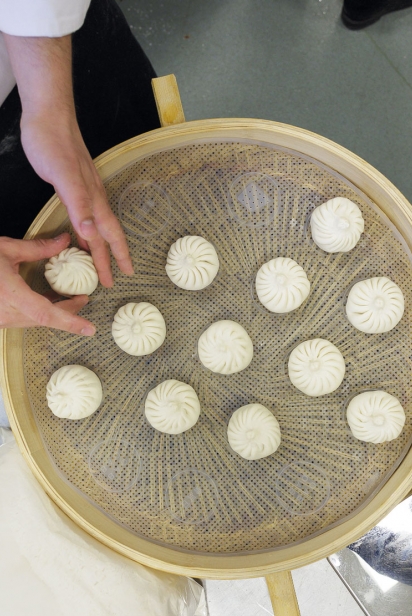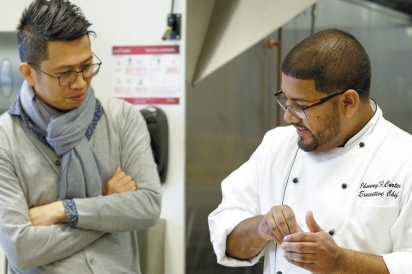The Baoist
Chinese Entrepreneur Tom Tong Brings an Ancient Culinary Tradition to Providence
When Tom Tong was growing up in China, he often accompanied his grandfather to the farmers’ market. “If I was a good boy,” Tong explains through a translator, “I would get a bao.” Tong treasures his childhood recollections of the soft steamed buns—variously called baozi, bao bao or simply bao—with their sweet or savory fillings.
The joy of that memory is so powerful, in fact, that it changed the course of Tong’s career and last February found him in Warren, Rhode Island, wooing a crowd of avid food-lovers with his beloved bao. Wearing a trim plum jacket and navy-and-plum windowpane- check pants, Tong cut a dapper figure as he watched chefs bring in oversize bamboo steamers laden with bao. The fistsized buns were filled with traditional Chinese fillings: ground pork; curried beef and potatoes; a vegetarian version with bok choy and fermented tofu; and another with purple sweet potato and taro.
The event was a tasting at Hope & Main, the nonprofit food business incubator, which is collaborating with Tong to create authentic bao in southern New England. A serial entrepreneur, Tong is the founder of GanQiShi BaoBao, which runs some 200 bao shops in China and has annual sales revenues of $30.7 million, China Daily News reported in March.
Seeing a new market of young diners with a taste for artisanal foods in the West, Tong is founding a U.S. chain, Tom’s BaoBao. His first restaurants will open in late summer at 326 Westminster Street in Providence and in Harvard Square in Cambridge. He plans to open another 20–30 restaurants on the East Coast by 2020. Meantime, Tong is flying back and forth among his stores in Shanghai and Hangzhou and southern New England, securing locations and permits, ordering locally made furniture, and finding regional purveyors who can meet his exacting standards.
A traditional breakfast or snack food in China, bao are eaten out of the hand (in Kung Fu Panda 3, the character Po enthusiastically, if mistakenly, eats them with chopsticks). Bao have a long and distinguished history, Tong says, dating back as long as 1,200 years. Fermented, or leavened, foods are a symbol of civilization, he points out, and the invention of the steamed buns is credited to the famous military strategist Zhuge Liang (181–234 AD), who created them to resemble human heads as a substitute for human sacrifice. For centuries, bao were honored as the food of the emperors— perhaps because it took an army of chefs to handle the dough and pinch and twist it to encase each filling properly.
But industrialization changed all that, and by the late 20th century, Tong says, bao had degenerated into the kind of street food wisely avoided. “They were very cheap,” he says. “There was no value. People would eat them only out of convenience.” As he describes this sorry state of affairs, Tong’s normally vibrant face clouds over.
Listening to Tong, even a non-Chinesespeaker can’t help but catch his infectious zeal for the project. The morning after the tasting at Hope & Main, I interviewed him and the ebullient COO of Tom’s BaoBao, Rosamond Lu, a Chinese-born resident of Milton, MA. She translated as Tong described his journey to bao. He studied engineering at Shanghai’s Tongji University and wrote a thesis on cooling systems for high-speed trains, but he never worked in the field, captivated instead by the thrill of start-ups. As a student he founded several businesses, including a shoe store, a hair salon and an internet café. But as he approached 30, “I was no longer a young man,” Tong says. “I felt the need to do something more. I wanted to do something that would bring me happiness and would bring happiness to others. “ In 2009 Tong opened the first in a chain of restaurants called GanQiShi BaoBao. His goal was not only to revive the ancient traditions of his beloved bao but also to give customers the joy he experienced as a child.
“It’s important to engage young people’s attitudes toward food,” he says. What’s more, he wanted to create a company that was authentic and pure—from the way the vegetables and animals are raised, to the way the bao are crafted, to the way the company trains, pays and treats its staff.
Rhode Island lawyer Clay Pell, a Hope & Main board member who speaks Mandarin, traveled to China with other members of the Tom’s BaoBao team last fall, and visited one of the farms where Tong’s pigs are raised. On his iPhone, Pell keeps a video clip he recorded of little black pigs romping while music played over loudspeakers (“They liked the classical music; they’d go there rather than to the field where the rock music was playing,” Pell laughs. “It was amazing.”)
To learn how to craft bao, chefs Jhonny [sic] Cortes and Gerry Furtado spent three months at GanQiShi’s training academy. Now dubbed Master Baoists, they will train the staff for the Providence store at Hope & Main. To steam the bao, the company is importing intricately woven bamboo baskets from a small village in the mountains of Fujian Province. “A handful of people in their 60s and 70s make them by hand—they can make only five or six a day,” Pell says.
One of the challenges any restaurant faces is creating a consistent supply chain—ideally one that doesn’t require it to import all of its own ingredients. Tong uses only Chinese soy sauce, aged in 100-year-old clay pots, with their generations of microorganisms contributing to the flavor. “The clay pot, the water, the air, all change the flavor subtly,” Lu explains.
In search of one-stop, quality ingredients, this March Tong, and other members of the team toured international distributor Sid Wainer’s emporium in New Bedford, MA. Wearing a huge quilted jacket and ball cap, Tong ogled the produce as a sales rep led the group through a series of refrigerated rooms, each kept at the ideal temperature for its contents. Tong’s eyes grew wide as he peeked inside a cardboard box filled with impeccably fresh sliced shitake mushrooms. Lu translated his question to the sales rep: “They are cleaned and sliced?” Clearly, mushrooms were not going to provide a problem.
Trickier, though, has been locating a source for flour. Baotzi require a medium-gluten winter wheat flour with the proper degree of hardness; as of May, the company hadn’t found a North American option that performed adequately and was still importing flour from China.
Meanwhile, construction on the shops proceeds apace. The architect’s drawings for Tom’s BaoBao show crisp, modern spaces— with lots of geometric white tiling and fun graphics. Glass walls showcase the kitchen, so that diners can witness the chefs pinching and pulling the dough, creating each perfect boa for steaming in those beautiful baskets.
The menu, as Tong describes it, will reflect a similar mix of authenticity and creativity. Although most of the fillings will be traditional— ground pork, curried beef, vegetable and sweet potato—the shops’ locations may inspire a handful of additions to the menu.
A New England version, for instance—with lobster.
For more information on store openings and traditional bao, visit TomsBaoBao.com.


